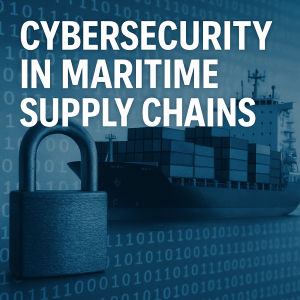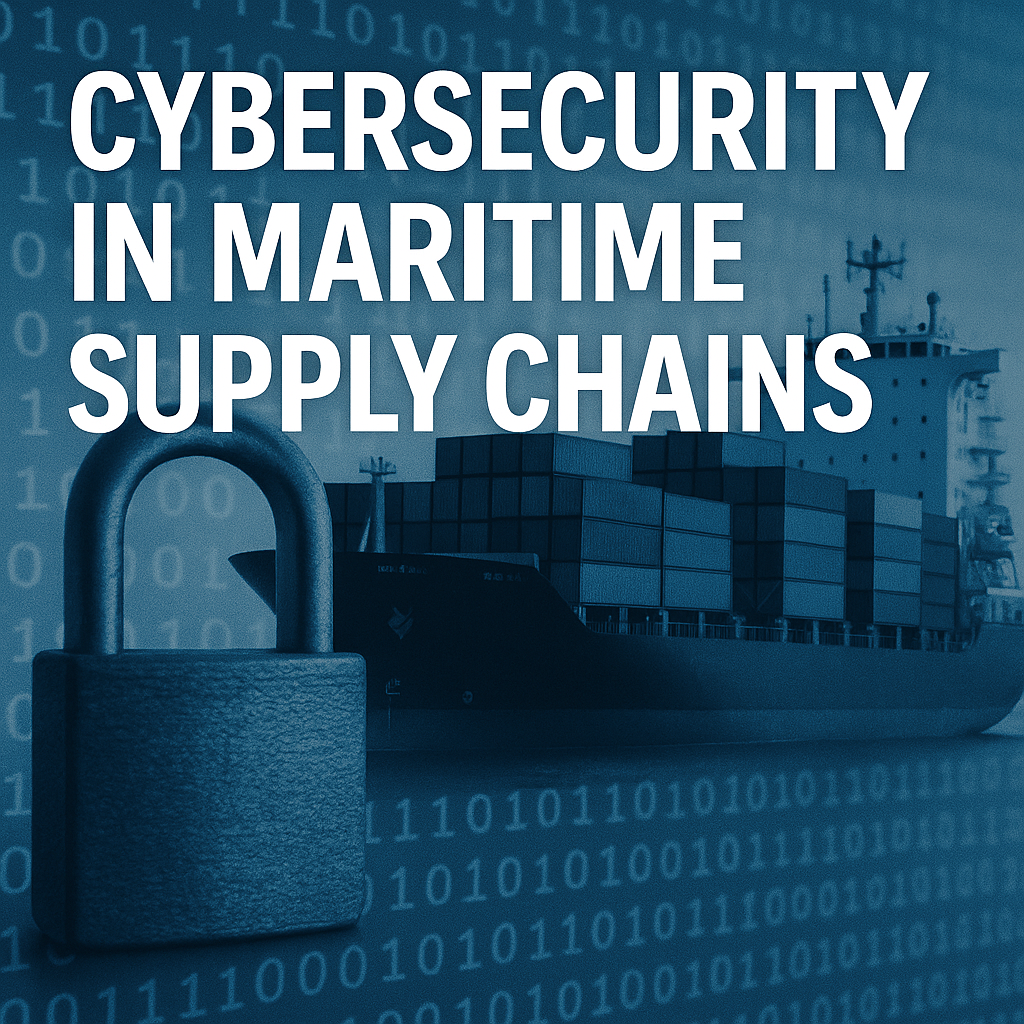
Discover how cybersecurity is reshaping maritime supply chains. Learn about hacking threats, supply chain vulnerabilities, and protection strategies in this comprehensive guide.
When the weakest link is digital 🔒
Maritime trade has always been about links—links between ports, ships, rail, and warehouses. But in 2025, the most fragile link is no longer a rusty anchor chain; it’s the invisible digital thread connecting every ship, port, and supplier.
Cybersecurity has moved from an IT department issue to a boardroom and bridge priority. Ransomware shutting down a port terminal can stall millions of dollars of trade daily. A hacked navigation system can redirect a vessel into danger. And malware hidden in a supplier’s software update—the classic supply chain attack—can spread across fleets worldwide before anyone notices.
The International Maritime Organization (IMO) has underlined this risk by requiring that cyber risk management be addressed in Safety Management Systems (SMS) from January 2021. Yet, the rise of advanced, coordinated cybercrime—often targeting suppliers—means the industry must evolve even faster.
This article explores how cybersecurity and supply chain protection are transforming maritime operations, why it matters, real-world cases, and how the sector can prepare for a future where data, not steel, is the most targeted asset.
Why cybersecurity matters in modern maritime operations
The maritime industry handles 80–90% of global trade by volume. This makes it a tempting target for cybercriminals, state-sponsored hackers, and opportunistic attackers.
Three factors make shipping particularly exposed:
-
Complex supply chains: Every vessel is part of a web involving shipbuilders, classification societies, equipment manufacturers, IT vendors, ports, and regulators. Each partner can be a potential attack entry point.
-
Legacy systems at sea: Many ships still rely on outdated operating systems and unpatched software, leaving exploitable gaps.
-
High disruption value: A successful cyberattack doesn’t just affect one company—it can ripple through entire regions, delaying cargo, raising costs, and even threatening safety at sea.
Consider the NotPetya cyberattack of 2017, which crippled Maersk’s operations globally. The malware spread via an infected accounting software update from a supplier—an archetypal supply chain attack. Maersk had to reinstall 45,000 PCs and thousands of servers, costing over USD 300 million in losses.
Such cases highlight a painful truth: you can protect your own systems, but you’re still vulnerable to your suppliers’ security gaps.
Anatomy of supply chain cyberattacks in maritime
Supply chain attacks exploit trusted relationships. Hackers target software updates, hardware components, or data transfers from suppliers that shipping companies inherently trust.
-
Software supply chain attacks: Malicious code inserted into updates of navigation software, port logistics platforms, or maintenance systems.
-
Hardware compromise: Counterfeit or tampered chips and components entering the supply chain.
-
Third-party service providers: Attackers gain access through contractors with weaker security, such as IT maintenance firms, port service providers, or cloud vendors.
These attacks are especially dangerous because they bypass traditional perimeter defenses. By the time they are detected, the malware is often already embedded across networks and fleets.
Key technologies and developments driving change
Endpoint security onboard ships
With ships becoming floating data centres, endpoint protection is critical. Firewalls, intrusion detection systems, and antivirus tools now extend beyond offices to engine control rooms, ECDIS systems, and satellite comms terminals.
Maritime-specific cyber regulations
-
IMO Resolution MSC.428(98): Requires cyber risk management in SMS.
-
IACS Unified Requirements E26/E27: Cyber resilience standards for ships built from 2024 onwards.
-
EU NIS2 Directive (2023): Expands cybersecurity obligations to critical infrastructure, including ports and logistics.
Threat intelligence and monitoring
Real-time monitoring of ship networks, combined with shore-based cyber command centres, helps detect anomalies such as unusual traffic to navigation servers.
Blockchain and secure data exchange
Blockchain pilots in ports (e.g., Rotterdam, Singapore) are testing tamper-proof supply chain documentation systems, reducing opportunities for data manipulation.
Challenges and barriers
Human factor
Over 70% of successful breaches start with phishing emails or human error. Seafarers and port staff often lack cybersecurity training, making them vulnerable targets.
Cost constraints
Smaller operators and regional ports may struggle to afford enterprise-grade cybersecurity. Attackers often exploit these weaker links as gateways into larger networks.
Fragmented supply chain responsibilities
Who is accountable if a cyberattack comes through a third-party software provider? Legal and insurance frameworks are still catching up, leaving grey zones in responsibility.
Evolving threats
Ransomware, AI-powered malware, and deepfake phishing calls are advancing faster than regulatory frameworks. Supply chain attacks often exploit zero-day vulnerabilities—unknown weaknesses with no patches yet available.
Case studies: Cybersecurity in action
Maersk and NotPetya (2017)
The NotPetya attack shut down Maersk’s global operations, forcing ships to sail “blind” without IT systems. Recovery required reinstalling thousands of devices in just 10 days. The lesson: resilience planning and supplier risk management are as important as firewalls.
Port of San Diego (2018)
A ransomware attack disrupted port IT systems, affecting logistics and billing. While physical operations continued, cargo clearance slowed, showing how even non-physical attacks can paralyse supply chains.
CMA CGM (2020)
A ransomware attack forced CMA CGM to shut down external access to its systems. Bookings and customer communications were disrupted, highlighting the vulnerability of digital customer portals.
Building resilience: Best practices for maritime supply chains
Map your supply chain’s digital footprint
Identify all third-party vendors—navigation software, engine manufacturers, port community systems—and assess their cybersecurity maturity.
Implement layered defenses
Combine firewalls, intrusion detection, network segmentation, and endpoint monitoring. A “defense in depth” approach reduces single points of failure.
Supplier audits and contracts
Include cybersecurity requirements in supplier contracts, covering data protection, incident response times, and patch management.
Crew training and awareness
From captains to cadets, everyone should recognise phishing attempts, suspicious USB devices, or unusual system behaviour. Regular drills should include cyber incidents alongside fire and abandon-ship scenarios.
Incident response and recovery plans
Have a clear playbook: isolation procedures, backup activation, and communications protocols. Regularly test these plans with realistic drills.
Future outlook: The cyber horizon in shipping
Looking ahead, maritime cybersecurity will only grow more complex:
-
AI-powered attacks and defenses: Hackers are using AI to craft sophisticated phishing or automate intrusions. In response, shipping companies will deploy AI-driven anomaly detection.
-
Digital twins with cyber monitoring: Ships and ports will have digital replicas not only for performance but also for cyber risk simulation.
-
Global collaboration: The IMO, IACS, and classification societies are expected to strengthen cross-border cyber reporting frameworks.
-
Insurance implications: P&I clubs are increasingly factoring cyber risk into coverage terms, pushing shipowners to demonstrate resilience.
The message is clear: cybersecurity is no longer optional—it is a license to operate.
FAQ
What is a supply chain cyberattack in shipping?
It’s when hackers target a supplier’s software, hardware, or services to gain access to shipping companies’ systems. The Maersk NotPetya case is a classic example.
Why is maritime especially vulnerable?
Because of complex supplier networks, outdated systems on many ships, and the high value of disruption in global trade.
Are seafarers part of cybersecurity defense?
Yes. Most breaches start with human error, so training crew in cyber awareness is as vital as maintaining fire drills.
Which regulations cover maritime cybersecurity?
IMO Resolution MSC.428(98), IACS UR E26/E27, and EU’s NIS2 are major frameworks. Flag states and classification societies are also issuing their own guidelines.
How can smaller operators protect themselves affordably?
By focusing on basics: strong passwords, timely updates, crew training, and clear supplier contracts. Affordable monitoring tools are also emerging for SMEs.
Will cyber insurance cover supply chain attacks?
Coverage varies. P&I clubs and insurers are increasingly requiring proof of risk management before offering coverage.
Conclusion: Navigating the invisible storm 🌐
The ocean has always tested mariners with storms and pirates. Today, the threats are digital—hackers probing ports, malware hiding in supplier updates, phishing emails luring crew. Yet the principle is the same: preparedness saves lives, money, and reputations.
By mapping supply chain risks, training crews, embedding cyber clauses in contracts, and investing in layered defenses, maritime professionals can steer through the invisible storm of cyber threats.
The future of shipping is digital, but it must also be secure. Cybersecurity is not just an IT issue—it is the ballast of global trade.
References
-
International Maritime Organization (IMO). (2021). Maritime Cyber Risk Management in Safety Management Systems (MSC.428(98)). IMO
-
IACS. (2024). Unified Requirements E26/E27 on Cyber Resilience. IACS
-
European Commission. (2023). NIS2 Directive on Cybersecurity of Critical Infrastructure. EU
-
BIMCO. (2022). Guidelines on Cyber Security Onboard Ships. BIMCO
-
Maersk. (2018). Annual Report: Lessons from NotPetya. Maersk
-
DNV. (2023). Maritime Cybersecurity Insights. DNV
-
Lloyd’s Register. (2022). Cybersecurity in the Maritime Industry. LR
-
EMSA. (2022). Guidelines on Maritime Cybersecurity. EMSA


thanks